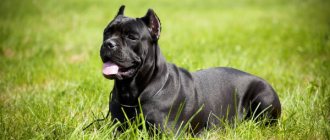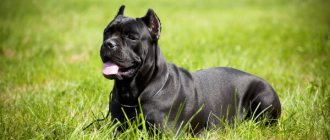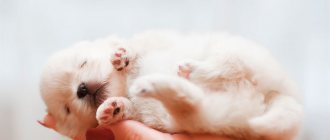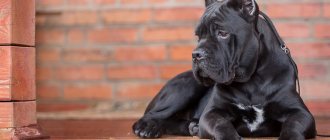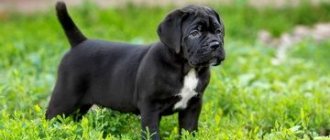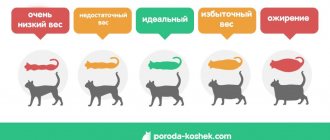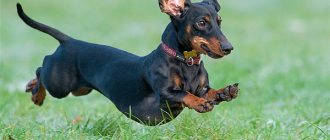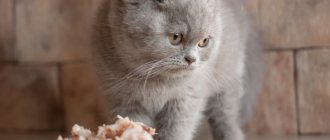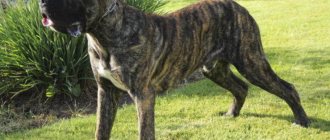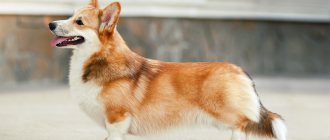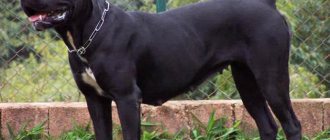One table of height and weight of a Cane Corso is not enough to understand whether your puppy is developing correctly, so in the article we will not only present it, but also tell you about the maturation of the Corso in detail. Every month, week and even day of a baby’s life is a lot of new discoveries.
Watching a tiny puppy grow into a strong, noble dog is a great pleasure. But it is important to know what he should be able to do at a certain stage, because deviations from the norm may indicate illness or psychological problems.
Typical diseases of this breed
Cane Corsos rarely get sick, but you should not neglect the prevention of common “canine” diseases.
Known Cane Corso diseases:
- distemper – for prevention, vaccinate your dog regularly;
- leishmaniasis;
- joint dysplasia;
- turning of the eyelids.
Cane Corso puppies: description, photo, price, selection criteria
Turning age (1-4 years)
After mating, Cane Corso dogs (especially males) again have a desire to take leadership positions.
Former comrades walking peacefully in the same yard strive to fight, finding out who is stronger.
Having great physical strength, the Cane Corso will be able to fight back and even cripple an opponent who is several times larger than him in height and weight.
The owner should not be frightened by this behavior; the most important thing is not to follow the pet’s lead, thereby allowing him to gain leadership.
It is necessary to treat the dog firmly and at the same time friendly . The process of education and training should be constantly carried out.
After puberty, dogs do not complete development; behavioral characteristics may change until the age of three.
It should be noted that the standard weight at 2 years is 38-45 kg for females and 48-55 kg for males.
How much does an adult Corso weigh?
To call an adult Italian Mastiff small is simply baffling. A dog whose height at the withers reaches 68 cm should rather be called huge, or at least large, but not small. Even though females may be slightly smaller than males, ranging from 60 to 64 cm, even they are impressively sized animals.
As for body weight, many factors influence it. So, for a Cane Corso that is more than three years old, normal weight is considered to be 45-50 kg for males and 40-45 for females. By the way, Italian mastiffs are considered adults only after they are 2-3 years old.
What affects the development of dogs
At different stages of a dog's life and development, different factors will influence its growth:
- During infancy, it is important for puppies to receive enough mother's milk. Those babies who are constantly pushed away from their mother by stronger brothers are fed by breeders with special mixtures from bottles with pacifiers.
- After the Corso has moved to a new home, weight gain and centimeters in height will be influenced by what food and how often the new owner feeds him. Feeding puppies that are not yet a year old should be as correct as possible. If a dog does not receive enough necessary vitamins, macro and microelements, it will not be able to fully develop both physically and mentally.
- In addition to nutrition, physical activity also influences the development of a mastiff. Dogs that receive physical activity will quickly build muscle, which will also give a noticeable “plus” on the scale.
- Females who have entered reproductive age can either gain or lose weight depending on how long ago they were pregnant and gave birth. It is especially important to monitor the weight and general well-being of females nursing offspring. If they don’t get enough of something, this will negatively affect the health of the puppies.
- Cane Corsos who have crossed the threshold of adulthood can either lose or gain extra pounds due to illness. During this period of life, examination by a veterinarian should be regular.
Important! Obesity, as well as underweight, should be a reason to consult a veterinarian.
Buying a puppy
The revived Cane Corso breed is relatively young, and today it is not easy to buy a purebred puppy of good blood. The cost varies from 15 to 90 thousand rubles depending on the class of the dog - breed, pet or show. The last one is the most expensive, exhibition one.
If you need a representative of the breed for participation in exhibitions and breeding, contact trusted breeders and do not save money. If you buy a cheap puppy, you risk getting a dog with congenital diseases or bad genetics.
Choosing a puppy
Choosing a puppy is a troublesome, but enjoyable task. You need to approach it wisely and consistently:
- Find a breeder. To do this, you should use the Internet, go to breed forums and read reviews there. A good breeder has a lot of them, there are mentions of the dogs on the Internet, it’s easy to find satisfied owners and mentions of which of them won which competitions. You can search by the name of the breeder, by the name of the nursery, by the names of the pets.
- Meet the breeder and animals. An adequate breeder will offer to get to know the puppy’s parents and himself - or wait until the bitch brings a litter and get acquainted then. It is important to pay attention to the conditions of detention and how the dogs look. Are they friendly, are they cheerful, do they have shiny fur, are they aggressive?
- Choose a specific puppy. Get acquainted with the documents - and he must have a pedigree, vaccination card and passport - get to know the baby himself. He must be healthy, have clean ears and a soft tummy, and be active and interested in exploring new people.
If you can’t meet in person, you can only rely on reviews and order your baby online. Most nurseries are ready to send a new family member by train or plane to anywhere in the country.
And if domestic nurseries are not satisfactory, you can always turn to foreign ones.
Character
The Cane Corso breed is prestigious and gaining popularity. The dog can be kept in an apartment or a private house - thanks to its medium size, it will take root well in any conditions. The only restriction that the canoe cannot tolerate is the chain. Left to guard the house, being tied to the booth. The dog will experience a lack of communication. In winter, the dog should be kept in a warm house.
All representatives of the breed have highly developed guard qualities. He protects everything that he considers his - family members, property, land. Constantly monitors the situation around him. Suspecting a guest of bad intentions, the Corso will let others know this. He will not be the first to attack; he will act only in response to aggression or on the orders of the owner.
He treats other pets with interest and friendliness if they do not encroach on his personal space.
Intelligent and unobtrusive, but enjoys playing outdoor games. Needs communication and a feeling of “usefulness”. Doesn't bark in vain - only gives voice in exceptional cases.
Cane Corso dog breed: characteristics, photos, character
From two to six months
After 8 weeks, little Corsos show individual traits for the first time, and you can see who is a sleepyhead, who is a leader, and who is prone to mischief. Little by little you need to expand the puppy’s living space. You can take him out into the yard in your arms for a short time so that he gets acquainted with the world around him.
By two months, the puppy should weigh from 6 to 8.5 kilograms.
From 12 weeks it is important to start socializing your little Corso, otherwise he will grow up withdrawn and fearful. Be sure to introduce him to other dogs and people. Let him see that the world is friendly to him, then he will also grow up sociable and cheerful.
Now the puppy is more inquisitive than ever. Rain is coming? Cool! Is there a vacuum cleaner in the corner? We need to study it. Did a car pass? Let's quickly run to look at her! At three months old, the Cane Corso is a tireless, fearless explorer, and the owner’s task is to make his discoveries joyful, not frightening.
The baby's interests change, and at 2-3 months he can be safely separated from his mother. He wants to learn, which means this is the best time for training.
At this age, males and females begin to gain weight in different ways: for the former, the norm at three months is 12-14 kg, for the latter – 10-13 kg.
From 4 to 6 months, the puppy begins to think about the hierarchy in the family, looks for its place, and tests the strength of its owners. This is normal, especially if you have a male. Just remember: in order to be recognized as the boss, you need to earn authority, but under no circumstances intimidate the poor animal.
For the first time, the baby “feels his gender” and shows sexual interest, jumping on the owner’s leg and other dogs.
At 6 months, males already weigh 26-32 kg, females - 24-28 kg.
Eight months to a year
Like humans, puberty in dogs is a time of protest, disobedience, and self-display.
Now the puppy may refuse to follow commands, rebel against your demands, and sometimes growl. Sometimes the dog begins to be jealous of the chosen family member towards others, including children. During walks, he “goes crazy” and runs completely different from where you are leading him.
Surprisingly, at the same time he is very shy and sensitive. Sometimes it seems that he has become a two-month-old baby again, who has never seen other dogs or strangers in his life.
The owner will have a difficult time during this period, since he needs to find a balance between the rigidity necessary to suppress aggressive behavior and kindness so that the teenage Corso does not feel rejected. In a word, everything about him is like a person’s.
At 8 months, males should weigh 38-40 kg, females - 34-36 kg. By the year the weight will increase: 44-46 kg and 38-43 kg, respectively.
After a year, up to 3-4 years, the personality of the Cane Corso still continues to develop, as does the body. Some character traits may change, and if you give a male dog for mating, after that he, feeling like a macho, will again try to push the owner off his “pedestal”. As always, you need to be firm, but loving and patient. By the age of two, males weigh, according to the standard, 48-55 kg, females - 38-45 kg.
How is your Cane Corso baby developing? Tell us about it in the comments and don't forget to like.
Training and education
From the very characteristics of the Cane Corso breed, it follows that these dogs are highly trainable, especially when the owner trains them. The basic rules are simple:
- The best encouragement for them is praise. Hunting dogs happily work for food. Loyal to their owners, Corsos are involved with the same enthusiasm in any activity in which people participate and for which they will be praised. Positive reinforcement with stroking, patting, and kind words is better for them than any other.
- You shouldn’t scold them too much if something doesn’t work out. An animal usually does something wrong not out of malice, but simply because it does not understand what a person wants. Therefore, any negative reinforcement must have a purpose: to convey a message, to show what exactly is wrong. This means that physical pressure, shouting or a stern tone are ineffective.
- They know how to imitate other dogs and learn from them. Therefore, learn commands well on the site, with other dog lovers. A trained dog does it - the Corso repeats, and everyone is happy. All a person can do is correct mistakes and give advice.
Otherwise, the principles of training are no different from the principles of training any other breed - constancy, consistency, practicality.
Consistency means that any rule must always apply, from the moment the puppy crosses the threshold. Even if at two months he is still very small, wrinkled and cute, it doesn’t matter. He will remember everything he learns now and will do exactly the same thing when he grows up. Therefore, you should not allow him to climb into bed, jump into people’s arms, or bite in play - then it will be very difficult to wean an adult pet.
Consistency means that the system of rules should be harmonious and uniform. You can't climb on the bed, okay. But you can’t climb on the sofa, or on the chair, or on the armchair. And in the morning, and during the day, and after a walk, and at night. And with the owner himself, and with children, and when there is no one at home - it’s also impossible. Only such rules will be clear to the dog: it must know why it is praised and what it is scolded for, and not get confused, which will inevitably happen if it is scolded and praised for the same thing at different moments.
Practicality means that any human action must carry the correct educational message. It already carries some kind of message - it’s just that many people don’t think about it in the process.
For example, a small puppy bites its owner in a game. At the age of three months, he just tries everything by the tooth and behaves with a person the same way he behaved with his brothers and sisters. If the owner continues the game, thinking that it was an accident or writing it off as normal children's pranks, the puppy will think that everything is normal, that it is okay to play like this. And then you will be very surprised if you start weaning it off.
Or the owner wants to reward the baby and puts a treat on the floor in front of him. After a few times, the puppy understands that the reward is placed on the floor, and begins to consider everything on the floor as its rightful prey: meat that has fallen from the table, the corpse of a pigeon lying on the asphalt in the street. And, again, he will be surprised and indignant if they try to take something away from him from the floor.
In parenting, a person must show responsibility and common sense, must think about his actions and clearly understand what messages he puts into the puppy’s head. And at six months he must take the mature teenager to service courses, where he will be taught how to properly protect people.
If something didn’t work out in the upbringing, and the pet persists in some behavior that the owners don’t like, you need to go to a dog handler: he will help you find out what the mistake was and show you how to correct it. As a last resort, you will have to go to a zoopsychologist.
In general, the training process is a fun and exciting activity.
